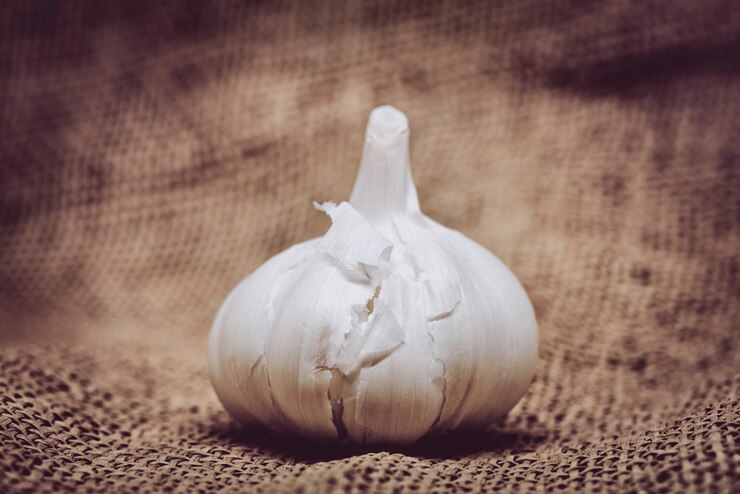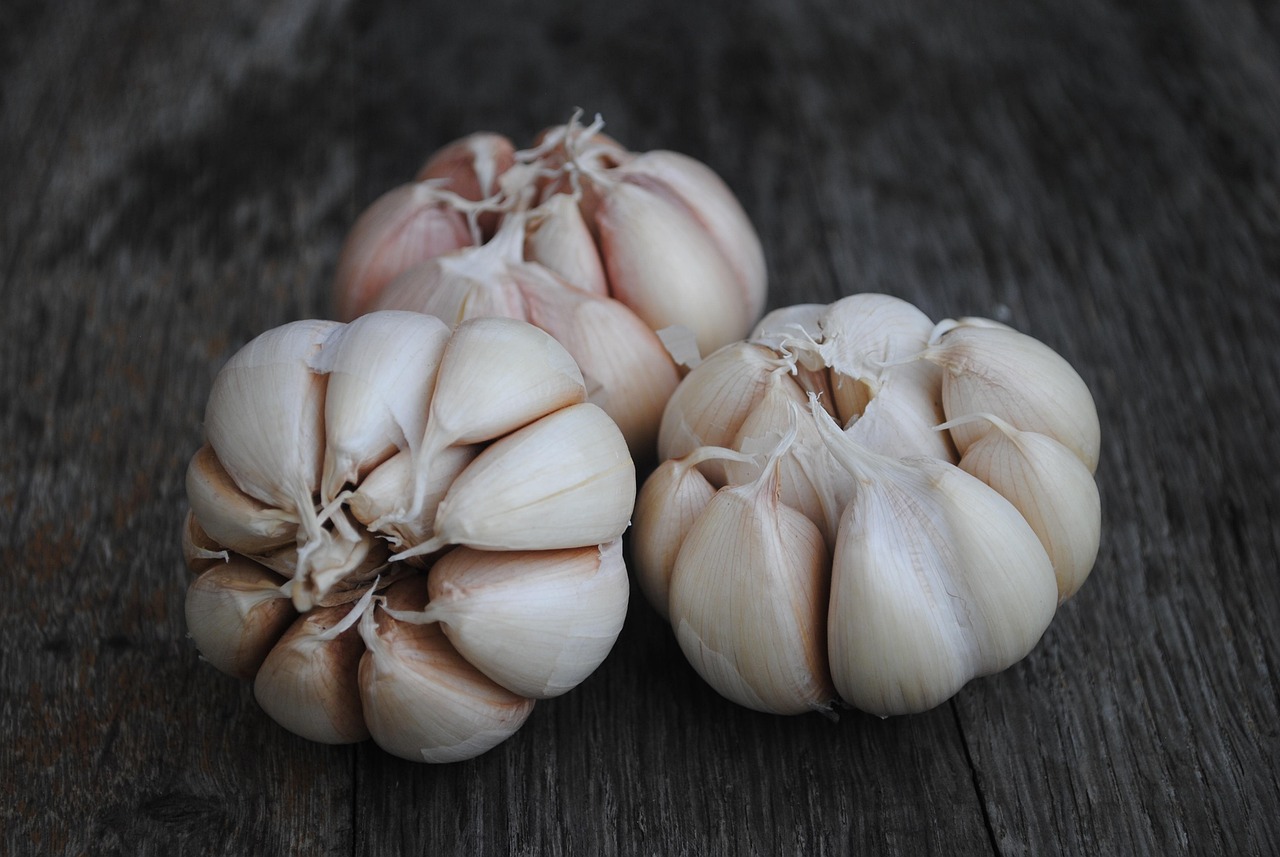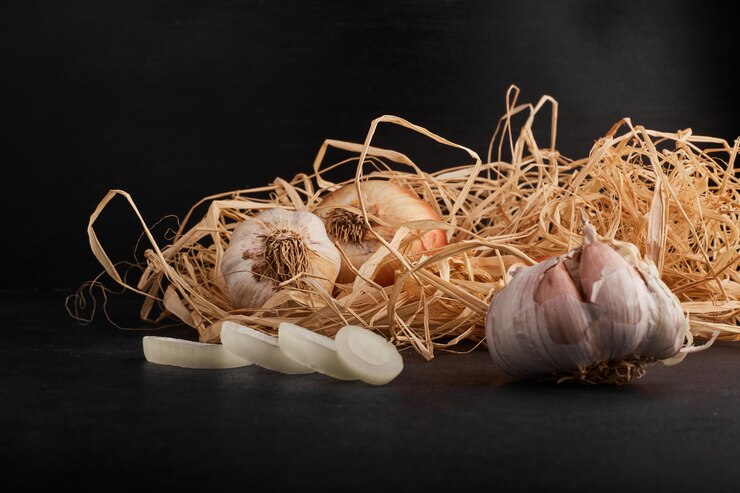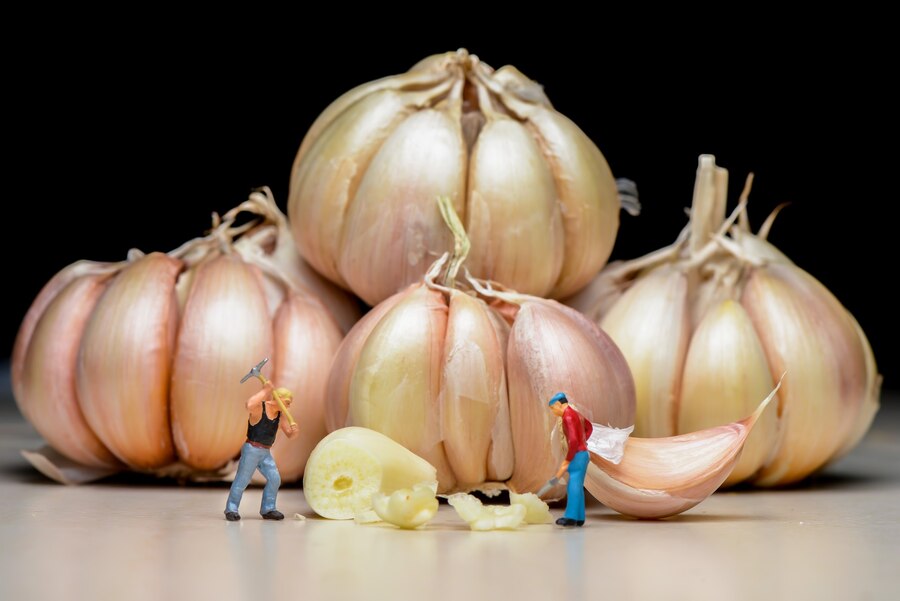ABOUT GARLIC
Elephant Garlic


At right, a clove of Elephant next to a nice-sized clove of regular garlic:
This Big Daddy has the largest bulbs and cloves of them all. It is the king of the roasters. Some Elephant individual cloves are larger than an egg!
Elephant is the mildest of the garlics, and is actually closer to a leek than a garlic. Awesome for stews, roast vegetables and garlic mashed potatoes. Elephant grows well in most parts of the country.
Since the bulbs will probably be larger than typical garlic, plant farther apart with a minimum of 6″ between cloves. Mulching with straw or grass clippings and keeping the soil relatively moist, even during the winter, promotes larger bulbs.

Elephant Bulblets or Bulbils (also incorrectly called korms): This is a fun way to gain some elephant garlic for your garden! Bulbils (aka bulblets) are seed-like growths found at the bottom of many elephant bulbs. They can be left in the ground after harvesting elephant garlic, or can be moved and replanted.
Soaking the bulbils for a few days, and even cutting/scoring a small slit in the bulbil toward the bottom can improve germination rates. The bulblets’ shell is very tough, so a score helps moisture get inside to allow the seed to expand and sprout. The shoots may not emerge until spring or early summer, so don’t forget where you plant them!
Plant the elephant bulbils this year, and expect to harvest “rounds” (large, round bulbs that have not yet formed multiple cloves per bulb) next year…although we have had some multi-clove bulbs form the first year from bulbils. Re-plant the “rounds,” and harvest potentially VERY large bulbs of elephant the following year.
All garlic seed for sale is supplied by our small micro farm in Elgin Oregon – Greifs Gourmet Garlic!
ABOUT GARLIC
The Rise and Fall of G1 Garlic: Lessons for Farmers and Traders

Have you ever wondered why some agricultural commodities skyrocket in value—only to crash just as quickly? The story of The Rise and Fall of G1 Garlic is a perfect example. Once hailed as the “white gold” of farming, G1 garlic saw explosive demand, record-high prices, and then a dramatic downfall that left many growers and traders in financial turmoil.
In this article, we’ll explore:
✔ What made G1 garlic so profitable—and why it collapsed
✔ Key mistakes that led to its downfall
✔ Practical strategies to avoid similar pitfalls in agribusiness
✔ Expert-backed insights on sustainable farming and trading
What Was G1 Garlic?
G1 garlic (Grade 1 garlic) was a premium variety known for its large cloves, strong flavor, and long shelf life. It gained massive popularity in global markets, particularly in China, India, and Africa, where demand surged due to its perceived superior quality.
Why Did G1 Garlic Boom?
Several factors contributed to its rapid rise:
✅ High Export Demand – Countries like China imported G1 garlic in bulk, driving prices up.
✅ Perceived Medicinal Value – Many believed it had stronger health benefits than regular garlic.
✅ Speculative Trading – Traders stockpiled G1 garlic, creating artificial scarcity.
✅ Government Subsidies (in some regions) – Incentives encouraged farmers to shift to G1 cultivation.
At its peak, G1 garlic sold for 3–5 times the price of regular garlic, making it a lucrative cash crop.
The Downfall: What Went Wrong?
Despite its early success, G1 garlic’s decline was swift and brutal. Here’s why:
1. Overproduction & Market Saturation
-
Farmers rushed to plant G1 garlic, leading to a supply glut.
-
Prices crashed when supply outstripped demand.
2. Quality Control Issues
-
Some traders mixed lower-grade garlic with G1, damaging its reputation.
-
Buyers lost trust, opting for cheaper alternatives.
3. Export Restrictions & Trade Wars
-
China, the biggest importer, imposed strict quality checks, rejecting substandard shipments.
-
Some countries banned G1 garlic imports due to pesticide residue concerns.
4. Price Manipulation by Middlemen
-
Traders hoarded stock, creating false scarcity, then dumped it, causing price crashes.
-
Small farmers, with no market leverage, suffered the most.
5. Shift to Alternative Varieties
-
New, disease-resistant garlic strains entered the market, reducing G1’s dominance.
Key Lessons for Farmers & Agri-Traders
The G1 garlic boom-and-bust cycle offers critical insights for anyone in agribusiness:
1. Avoid Overdependence on a Single Crop
-
Diversify crops to spread risk.
-
Example: Farmers who grew both G1 garlic and onions suffered less when garlic prices fell.
2. Focus on Quality & Certification
-
Maintain strict quality control to preserve market trust.
-
Obtain organic or export certifications to access premium markets.
3. Understand Market Trends
-
Monitor global demand shifts and trade policies.
-
Use tools like FAO reports, USDA data, and local agriculture extensions for insights.
4. Build Direct Buyer Relationships
-
Bypass middlemen by selling directly to exporters or via farmers’ cooperatives.
-
Example: Some Kenyan garlic farmers now use blockchain-based traceability to attract international buyers.
5. Adopt Smart Storage & Pricing Strategies
-
Use cold storage to prevent spoilage and sell during price spikes.
-
Hedge prices through futures contracts (if available).
The Future of Garlic Farming: What’s Next?
While G1 garlic’s glory days may be over, garlic remains a high-demand crop. Here’s what experts suggest:
🔹 Switch to Resilient Varieties – New hybrids offer better yield and disease resistance.
🔹 Explore Value-Added Products – Garlic powder, oil, and supplements have steady demand.
🔹 Leverage E-Commerce – Platforms like Alibaba, Amazon Fresh, and local agri-marketplaces help farmers reach global buyers.
Final Thoughts: Will Garlic Make a Comeback?
The rise and fall of G1 garlic teaches us that short-term booms are risky without sustainable strategies. Farmers and traders must:
✔ Stay informed about market trends.
✔ Prioritize quality over quick profits.
✔ Diversify income sources to withstand price shocks.
ABOUT GARLIC
HOW TO STORE GARLIC

HOW TO STORE GARLIC
Stored properly, fresh garlic will last for months. Commercially, garlic is stored between 30 and 32 degrees. In most households that is not possible. Here are some other ideas on how to store garlic.
- Bundle garlic in bundles of 8 to 12 bulbs by tying the stalks and hanging it, bulb down. Store garlic in a cool, dry place, with plenty of circulation, away from sunlight.
- You can purchase a ‘garlic keeper’ or simply store it in a wire basket under a flower pot.
- For a homespun display, you can braid softneck garlic stems together, adorned with ribbon and dried flowers, and hang it in your kitchen.
HOW ABOUT DEHYDRATING?
It’s easy and you’ll be amazed at how flavorful fresh garlic powder is compared to commercially purchased garlic powder.
- Break the cloves apart.
- Cut the root end of the clove (you may also peel the clove, but it is not necessary).
- Lay the cloves in a single layer in your dehydrator and dehydrate for 16+ hour depending on your dehydrator and the size of the cloves.
- The skins fall right off!
- You can store whole cloves or grind them into powder.
- Store in an airtight container. OR…
- To make garlic salt, mix 3 parts salt and 1 part garlic.
GARLIC IN WINE OR VINEGAR
- Peeled garlic cloves can be stored in wine or vinegar and refrigerated.
- Garlic can be stored in this manner for about 4 months.
- Discard if you see any signs of mold or yeast growth.
REFRIGERATION
- While it can be done, refrigeration is not the best way to store your garlic because it changes its texture, flavor, and speeds germination.
FREEZING
- Garlic can be stored in the freezer but keep in mind that freezing garlic changes its texture and flavor.
- You can freeze entire bulbs and use individual cloves when you need them, OR
- Peel, chop, and store in small Ziploc bags. If you fill the bags lightly and freeze them flattened you can break off what you need later.
HOW NOT TO STORE FRESH GARLIC
- Never store garlic in oil. Garlic in oil can be kept in the refrigerator for a maximum of 2 weeks. After that, it can develop dangerous bacteria/toxins.
- Garlic and oil at room temperature can cause dangerous toxins to form.
PEELING GARLIC
Here are some helpful hints to make peeling your cloves a little easier.
Blanch in boiling water for approximately 20 seconds, then drop into icy cold water. The skins will slip right through your fingers.
- Place cloves in a glass of cool water for 30 minutes and the skins will come right off.
- Using the old fashioned method, trim off the top and bottom of the clove and roll it between your fingers.
- Trim off the bottom of the clove, place flat on your counter or cutting board, pop it with the flat end of a knife.
- Purchase a ‘garlic tube’. It’s basically a flat piece of silicone. Wrap the cloves in the tube and roll it on the counter a few times.
All garlic seed for sale is supplied by our small micro-farm in Elgin Oregon – Greif’s Gourmet Garlic!
ABOUT GARLIC
Global Garlic Export Business Growth Potential: Analysis for 2024

The global garlic export business has been steadily growing, driven by rising consumer demand for this versatile ingredient. Garlic, known for its culinary uses and health benefits, has found its place in kitchens and healthcare markets across the globe. With the increasing interest in plant-based diets, natural health remedies, and international cuisines, the garlic export market is expected to grow significantly in the coming years. In this article, we explore the global garlic export business growth potential for 2024, looking at market trends, key players, challenges, and opportunities.
Introduction to the Global Garlic Export Market
Garlic is one of the oldest cultivated plants in the world. It is native to Central Asia but is now grown in various regions across the globe. The primary use of garlic is in the culinary industry, where it enhances the flavor of dishes. However, garlic also has medicinal properties, contributing to its expanding use in the pharmaceutical and wellness industries.
According to a report by MarketsandMarkets, the garlic market is expected to grow at a compound annual growth rate (CAGR) of 3.7% from 2024 to 2029. The market’s growth is driven by factors such as the increasing demand for garlic-based food products, rising awareness about its health benefits, and the expansion of garlic production in key exporting countries.
Global Garlic Market Size and Demand
The global garlic export market is valued at billions of dollars, with China leading the way as the largest producer and exporter. In 2023 alone, global garlic exports were valued at over $10 billion. This growth can be attributed to the rise in demand from both developing and developed countries. Garlic’s applications extend beyond traditional food use, as it is now widely included in health supplements, cosmetics, and functional foods.
The demand for garlic has expanded in regions like the Middle East, Southeast Asia, and North America, which increasingly value its health benefits and culinary versatility. As consumers lean towards more plant-based and natural food options, garlic continues to gain traction.
Key Exporting Countries
1. China:
China is by far the largest producer and exporter of garlic, accounting for nearly 80% of the global garlic export volume. The country’s favorable climate, large-scale agricultural production, and established export infrastructure have contributed to its dominance in the garlic export market.
2. India:
India is another major garlic exporter, although its export volume is significantly smaller than China’s. The country’s garlic production is mostly concentrated in the northern and western states. India’s export potential is growing as demand for its high-quality garlic, often used in spice mixes and health products, continues to increase.
3. Spain:
Spain is the leading European garlic exporter, particularly supplying the European Union with fresh garlic. Spain’s garlic industry is well-organized, and the country is known for its high-quality varieties, such as the “Morado” garlic. Spain is also increasingly targeting international markets outside the EU.
4. Argentina:
Argentina is one of the top garlic producers in South America. The country has a growing garlic export business, primarily focused on the North American and European markets. Argentina’s garlic is particularly known for its organic production methods, which appeal to health-conscious consumers.
5. Egypt:
Egypt is rapidly emerging as a strong contender in the global garlic export market. With favorable growing conditions and significant investments in agricultural technology, Egypt is expected to continue increasing its export share in the coming years.
Global Garlic Export Trends in 2024
The global garlic export business growth potential in 2024 is influenced by several key trends:
1. Increasing Demand for Organic Garlic
As consumers become more health-conscious, the demand for organic products, including organic garlic, is on the rise. Organic garlic is free from pesticides and chemical fertilizers, making it an attractive choice for health-focused consumers. This trend is particularly strong in North America and Europe.
2. Garlic-Based Products on the Rise
Garlic’s versatility is driving the growth of garlic-based products such as garlic paste, garlic oil, and garlic powder. These products are convenient, have longer shelf lives, and are widely used in various cuisines. The market for garlic supplements is also expanding, with garlic touted for its cardiovascular and immune-boosting properties.
3. E-commerce and Direct-to-Consumer Sales
The rise of e-commerce has made it easier for garlic exporters to sell directly to consumers. Online platforms allow exporters to reach a global audience, bypassing traditional distribution channels. This shift is particularly significant in markets like the United States, where consumers increasingly prefer to purchase products online.
4. Sustainability and Traceability
Consumers are increasingly interested in the sustainability and traceability of the products they purchase. Garlic producers and exporters are adopting more sustainable farming practices and transparent supply chains to meet this demand. Certifications such as Fair Trade and organic labels are gaining importance in the garlic export market.
5. Export Restrictions and Supply Chain Challenges
Despite the growth potential, the garlic export business faces challenges, particularly regarding supply chain disruptions and trade restrictions. In 2024, geopolitical factors and global inflation could impact the garlic export market. For instance, China’s dominance in garlic production could be affected by trade tensions, and labor shortages in some countries could lead to production delays.
Global Garlic Export Statistics by Country (2023)
| Country | Export Volume (Metric Tons) | Market Share (%) | Main Export Regions | Notable Garlic Varieties |
|---|---|---|---|---|
| China | 2,400,000 | 80% | North America, Europe, Asia | “Shandong,” “Purple Stripe,” “Lao-Gao” |
| India | 250,000 | 8% | Middle East, North America | “Lahore,” “Indian White” |
| Spain | 100,000 | 4% | European Union, North America | “Morado,” “Ajo de Las Pedroñeras” |
| Argentina | 50,000 | 2% | North America, Europe | “White,” “Purple” |
| Egypt | 30,000 | 1.2% | Europe, Asia | “Baladi,” “Alexandria” |
Garlic Export Business Opportunities
The global garlic export business growth potential presents numerous opportunities for both large-scale producers and small-scale exporters. Here are some of the key opportunities in the market:
1. Expanding into Emerging Markets
As the demand for garlic grows in emerging markets such as Africa and Latin America, there is significant potential for garlic exporters to expand into these regions. The increasing adoption of Western diets and growing awareness of garlic’s health benefits are contributing to this trend.
2. Garlic as a Health Ingredient
The growing popularity of natural health products presents an opportunity for garlic exporters to target the wellness sector. Garlic’s reputed health benefits, including its potential to lower cholesterol, improve cardiovascular health, and boost immunity, make it a valuable ingredient in supplements, functional foods, and personal care products.
3. Innovation in Value-Added Products
Exporters can tap into the value-added garlic product market, offering garlic paste, dried garlic, garlic oil, and even garlic-infused cosmetics. The demand for convenient, ready-to-use products continues to rise, particularly in the busy, health-conscious consumer market.
4. Direct-to-Consumer Sales and Online Platforms
The direct-to-consumer model offers a low-cost way to reach global buyers. Garlic exporters can set up online stores, collaborate with e-commerce giants, or even sell on specialized health and wellness platforms. This model eliminates middlemen, making it easier for consumers to access high-quality garlic products.
Challenges in the Garlic Export Business
While the garlic export business shows immense potential, there are several challenges that exporters must address:
1. Price Volatility
Garlic prices can be highly volatile, particularly in major producing countries. This price fluctuation can be attributed to factors such as crop yields, climate conditions, and market demand. Exporters must find ways to mitigate risks, including diversifying supply chains and securing long-term contracts.
2. Competition from Local Producers
As the garlic market grows, competition from local producers in various countries is intensifying. This could affect the market share of major exporters, such as China. Exporters need to differentiate their products by focusing on quality, sustainability, and innovation.
3. Regulatory Compliance
Garlic exporters must adhere to the regulatory requirements of importing countries. These regulations can vary significantly, requiring exporters to stay informed about changing import policies, quality standards, and labeling requirements. Non-compliance can result in delays, fines, or even product rejection.
4. Supply Chain Disruptions
The garlic supply chain is vulnerable to disruptions due to weather events, political instability, and economic factors. Global shipping issues, such as port congestion or rising fuel costs, can increase transportation expenses and lead to delays in product delivery.
Conclusion
The global garlic export business growth potential in 2024 is promising, driven by expanding demand from international markets, the rise of health-conscious consumers, and the growing popularity of garlic-based products. However, the industry must overcome challenges such as price volatility, regulatory complexities, and supply chain disruptions. Exporters who can innovate, meet quality standards, and adapt to changing consumer preferences will be well-positioned to succeed in this thriving market.
For businesses looking to enter the garlic export industry, now is an ideal time to capitalize on the global growth trends. With strategic investments in production, marketing, and distribution, exporters can take advantage of the garlic market’s vast potential and make their mark on the global stage.
-

 Articles3 months ago
Articles3 months agoHow Many Times Can You Regrow Green Onions
-

 News10 months ago
News10 months agoUnderstanding HotLeaks: What You Need to Know
-

 Fashion8 months ago
Fashion8 months agoOpals in the USA: A Gemstone Transforming the Crystal Healing Market
-

 Entertainment7 months ago
Entertainment7 months agoHow to Use Snaptik: A Complete Guide to Download TikTok Videos
-

 Technology1 year ago
Technology1 year agoThe Wonders of Oh Em Gee Blog
-

 Entertainment1 year ago
Entertainment1 year agoBare it All: Unforgettable Skinny Dipping Stories Shared
-

 Health1 year ago
Health1 year agoCan You Smoke Shrooms? Exploring the Myths and Realities
-

 Articles5 months ago
Articles5 months agoWHAT IS THE DIFFERENCE BETWEEN SEED GARLIC AND FOOD GARLIC?
